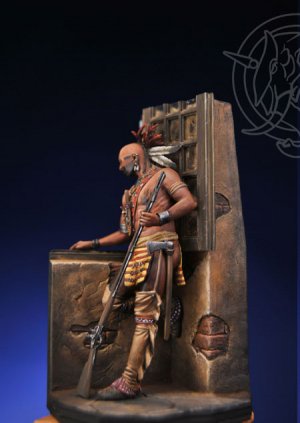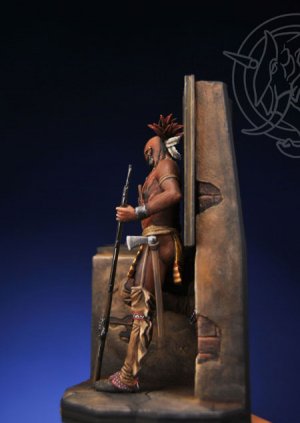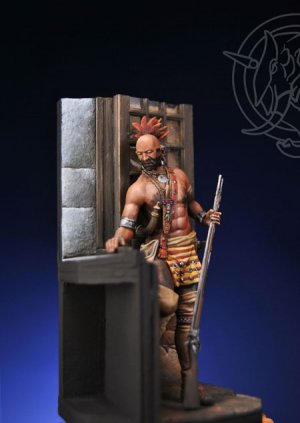





Ref.: ROME-75018

Iroquois Warrior in a Casle - Mid XVIII Century
History The Iroquois were redskins who occupied the woodlands of the American east and south-east, that is, the Great Lakes region, south of the Ontario, part of the coast, and the territories east of the Mississippi. The Hurons, Cherokee, Erie and Mohawks also belonged to the same family. These Indians were farmers and excellent warriors. Around the year 1570 they organised themselves, forming confederations, in order to halt the expansion of the European colonialists. In the reserves of the Great Lakes some few thousand still exist.They speak a simple language made up of five vowels and eight consonants. The first contacts between the North American Indians and the white man came about at the beginning of the XVI century when European fishermen, mainly French and Portuguese, settled on the island of Newfoundland, from where they engaged in friendly and commercial relationships with the Indians for the purpose of procuring food and furs. At the end of the XVI century the American fur trade, beside setting the fashion of the time, became a source of great interest for the European powers. In the meantime, traders were profiting from the intuition that direct trade with the Indians could bring them advantages. Influenced by the lifestyle of the white man, the Indians radically changed their philosophy on hunting, which had previously been solely to procure food for the tribe, and contributed to the extermination of fur animals in North America, so that they could possess firearms, metal daggers, beads and trinkets, mirrors and other fancy goods, unknown until then or considered unimportant. In the course of the same century, North America had been explored and populated mainly by the French and English. Hunting and the extermination of wild animals led the Indians to migrate and occupy new territories, which in its turn was responsible for conflict between the tribes and the outbreak of the “fur wars”. The English and French competed with each other in giving weapons and alcohol to the Indians who occupied areas strategic for the fur trade. Between 1610 and 1640 there was an unceasing demand from Europe for furs. The Hurons created a commercial empire among all the Great Lakes tribes, extending as far north as Hudson Bay. Their total access to the north-west territories was barred by the presence of the Iroquois, who tried to take over the trade of the Hurons, who, in the meantime, were taking advantage of their alliance with the French, who had become enemies of the Iroquois following fighting in 1615. In 1640 the English and Dutch armed the Iroquois who then overcame the Hurons and dispersed them. However, they didn’t manage to take over their trade, and suffered retaliation at the hands of the French, who attacked them and rendered them harmless. Weakened by the fighting with the Hurons and the French, the Iroquois were compelled to form an alliance with the English, who, following their expansionistic aims, settled once and for all in the region of modern-day New York. The Indians were subsequently involved in the American chapter of the Seven Years’ War among the European powers (1753-1763). The Paris Treaty of 1763 saw the end of French dominion in North America, and the territories passed under English domination. In 1775, when the War of Independence broke out between the American colonies and England, the Iroquois were once again allied to the English. In 1782, when the English were defeated and America obtained its independence, the Iroquois were left to their fate. The Americans negotiated with them, considering them among the most dangerous natives, and a decree of the War Department in 1787 recognized for all the Indian tribes, the right to exist as independent nations. In the same year the Constitution was drawn up without taking the needs of the Indians into consideration, and therefore the birth of the United States of America sanctioned the disappearance of the Indian nations. The non-respect of the decree and the continuous breaking of treaties on the part of the white man led to fresh and exhausting conflicts that witnessed the decimation of the Indian tribes, including the Iroquois.